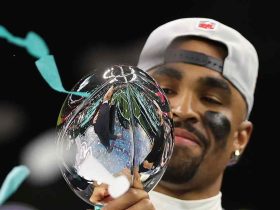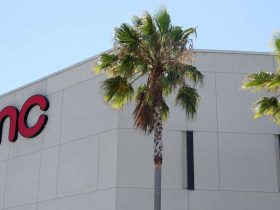Bond index funds are having their third bad year in a row. It isn’t just rising interest rates.
The largest bond exchange-traded fund, the $94 billion
Vanguard Total Bond Market
ETF, is down almost 3% this year after losing 13% in 2022.
Some losses are inevitable in a rising interest-rate environment, as bond prices move inversely with rates. Yet there are flaws in bond index funds that can make them vexing in any environment. Today’s rate environment could exacerbate them.
Both Vanguard Total Bond Market (ticker: BND) and the $89 billion
iShares Core U.S. Aggregate Bond
ETF (AGG) track a variation of the Bloomberg U.S. Aggregate Bond Index, or “Agg,” although in Vanguard’s case there is a slight emphasis on the benchmark’s more liquid bonds. Both have beaten about 60% of their Morningstar Intermediate Core Bond fund category peers in the past 10 years. That’s respectable, but pales in comparison to major stock index funds like
iShares Core S&P 500
(IVV), which has beaten 91% of its Large Blend peers during the same period.
One reason indexing bonds is problematic is the bond market’s sheer scale and number of outstanding issues. “In the equity markets, there’s essentially only one security per issuer for a company, and the price of that security is observable at all times when the markets are open,” says Brad Libby, manager of the top-performing
Hartford Municipal Opportunities
(HMOP). “Bonds are much less efficient.” He points out that there are multiple securities to trade from each corporate or municipal bond issuer: “There are actually 328 different fixed-income securities of
Verizon
(VZ), and each one has a different [interest rate] coupon, or a different maturity or a different possible call date.”
The bottom line is that bond index funds perform superbly for widely traded securities and liquid securities like Treasuries, but not nearly as well for illiquid corporate or municipal issuances.
In the muni bond market, there are over 1.1 million individual bonds from over 50,000 different issuers, according to IHS Markit. It’s impossible to index all of these, so it makes sense that Libby is able to buy a small batch of overlooked, attractively priced bonds and beat indexes.
Because many bonds are illiquid and don’t trade daily, they are often omitted from index ETFs that trade in milliseconds. In the Agg’s case, there are entire bond sectors it avoids, not just for credit quality but also for liquidity reasons. By contrast, active managers can pick and choose where they want to make their liquidity or illiquidity bets, gaining an edge on the benchmark.
Illiquid nonagency mortgage debt, which crashed during the subprime crisis in 2008, has been essential to the $127 billion Pimco Income Fund’s (PONAX) outperformance of the Agg since then. Such mortgages can also have high credit quality today, as housing prices have increased since 2008 and the borrowers’ finances have stabilized. “The success of passives [indexing] has created huge opportunities” for active management, says Pimco Income manager Dan Ivascyn. That non-indexed opportunity set includes nonagency debt, bank loans, and asset-backed securities—all of which Ivascyn exploits.
Indexing icon Vanguard runs some of the best actively managed bond funds. While the indexed
iShares iBoxx $ High Yield Corporate Bond
(HYG) has gathered $11 billion in assets, Vanguard has never launched an indexed high-yield fund. Instead, it runs Vanguard High-Yield Corporate (VWEHX), which, though actively managed, has a lower 0.23% expense ratio than the index ETF’s 0.49% and has beaten the ETF in most time periods.
“In the high-yield market, there can be very wide dispersion of [individual bond performance] outcomes that, with the right kind of research, can set up a strong active manager to outperform,” says Jeff Johnson, head of fixed-income product at Vanguard. The wide performance dispersion in high yield is partially due to the higher instance of default in high-yield bonds and their lower liquidity than high-quality debt.
BlackRock, which manages the indexed iBoxx $ High Yield Corporate Bond ETF, recognizes the importance of both active and passive funds. Jonathan Diorio, head of product management at BlackRock Wealth Advisory, recommends the HYG ETF more for institutional clients who want a “beta play”—that is, to get liquid market exposure in the high-yield space quickly to potentially trade. But for long-term retail investors, he thinks the active mutual fund BlackRock High Yield Bond Portfolio (BHYAX) is preferable.
“We’ve been able to show that we can outperform over time with our high-yield mutual funds,” Diorio says. BlackRock’s active fund has beaten HYG in most periods, despite the fact the mutual fund has a higher 0.94% expense ratio.
Generally speaking, the lower the credit quality, and the less liquid and more exotic a bond sector is, the more active management makes sense. “The more efficient the market is, the more likely an index is going to reflect an accurate picture of that market, as long as the index is relatively inclusive and information [on securities] is appropriately priced in,” says David Sherman, manager of the top-performing RiverPark Strategic Income (RSIVX).
It is also true that when interest rates are low, fund management fees consume a greater portion of the income bonds produce. That puts high-cost active managers at a distinct disadvantage to indexes. But the reverse is also true as rates rise, so today’s rate environment favors active management.
Write to [email protected]
Read the full article here











Leave a Reply